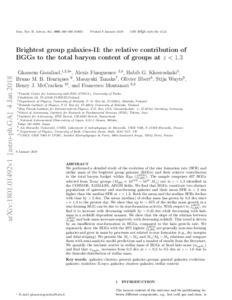Brightest group galaxies – II: the relative contribution of BGGs to the total baryon content of groups at z < 1.3
Bruno M B Henriques; Alexis Finoguenov; Stijn Wuyts; Masayuki Tanaka; Francesco Montanari; Ghassem Gozaliasl; Henry J McCracken; Olivier Ilbert; Habib G Khosroshahi
https://urn.fi/URN:NBN:fi-fe2021042718769
Tiivistelmä
We performed a detailed study of the evolution of the star formation rate (SFR) and stellar mass of the brightest group galaxies (BGGs) and their relative contribution to the total baryon budget within R200 (
). The sample comprises 407 BGGs selected from X-ray groups (M200 = 1012.8–1014 M⊙) out to z ∼ 1.3 identified in the Cosmic Evolution Survey (COSMOS), XMM Large-Scale Structure survey (XMM-LSS), and the All-Wavelength Extended Groth strip International Survey (AEGIS) fields. We find that BGGs constitute two distinct populations of quiescent and star-forming galaxies and their mean SFR is ∼2 dex higher than the median SFR at z < 1.3. Both the mean and the median SFRs decline with time by >2 dex. We take into account the halo mass growth of groups in selecting the sample of BGGs and find that the mean (median) stellar mass of BGGs has grown by 0.3 dex since z = 1.3 to the present day. We show that up to ∼ 45 per cent of the stellar mass growth in a star-forming BGG can be due to its star formation activity. With respect to
, we find it to increase with decreasing redshift by ∼0.35 dex, while decreasing with halo mass in a redshift-dependent manner. We show that the slope of the relation between
and halo mass increases negatively with decreasing redshift. This trend is driven by an insufficient star formation in BGGs, compared to the halo growth rate. We separately show the BGGs with the 20 per cent highest
are generally non-star-forming galaxies and grow in mass by processes not related to star formation (e.g. dry mergers and tidal striping). We present the M⋆–Mh and M⋆/Mh–Mh relations and compare them with semi-analytic model predictions and a number of results from the literature. We quantify the intrinsic scatter in stellar mass of BGGs at fixed halo mass (
) and find that
increases from 0.3 dex at z ∼ 0.2–0.5 dex at z ∼ 1.0 due to the bimodal distribution of stellar mass.
Kokoelmat
- Rinnakkaistallenteet [19207]
